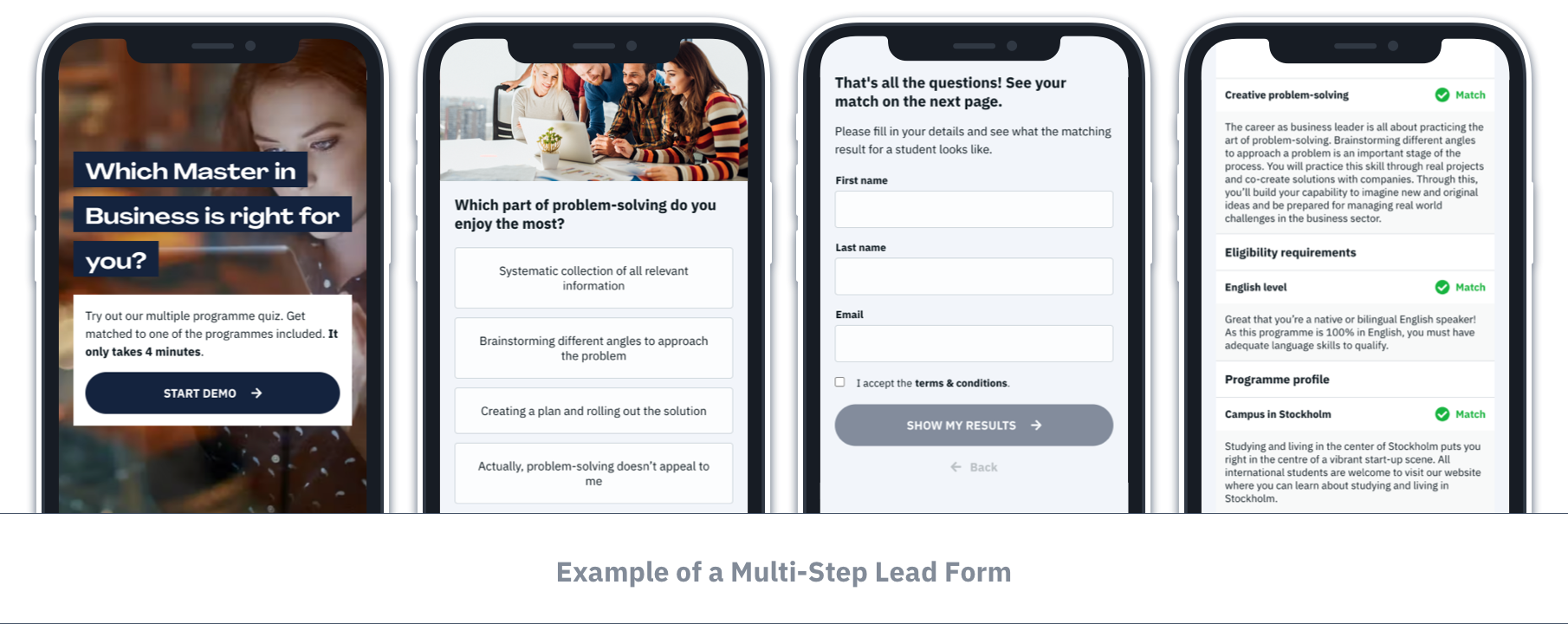Lead generation strategies
Increase Student Lead Conversion with a Multistep Leadform
2021-10-01 · 3 min read
Are you struggling to capture students who browse your website but aren't ready to download a brochure, contact a student advisor or apply to the programme?
It's time to try something new.
A "multi-step" lead form can get you stronger engagement and more student leads for your marketing efforts. The user experience of our is like an interactive quiz.
To understand the benefits of multi-step, let's first examine the brochure download. By far, the most common lead capturing technique in the education industry.
Picture the lead form students fill in before getting their hands on the brochure as a kind of 'single-step form'. With conversion rates in the range of 3% and up, you might be thinking that's not bad going considering the average attention span online.
Well, multi-step lead forms can generate student conversion rates from your website of up to 70%.
All in all, the brochure download isn't ideal for today's generation of tech-savvy students.
- Mobile users: Everyone is on their phone, all the time. Nearly 99% of Facebook users access the site on mobile. Navigating a PDF brochure on your smartphones is a negative user experience.
- Privacy concerns: Personal details are now hard currency given data security issues. Prospective students are asking - 'Is sharing my contact details a fair price for a brochure?'. And the answer is, probably not.
Introducing the Multi-Step Lead form
A mobile-friendly and more importantly, user-friendly technique for capturing data is the multi-step lead form. By asking just one question per step, with up to 12 steps in the same lead form, you'd be surprised at the level and amount of information you could gather.
It's a winning formula for breaking down a lengthy communication into a mobile-friendly format, too.
Why Do Multi-Step Lead Forms Convert Better?
The Secret Sauce - Escalation of Commitment
The key to its success lies in the phenomenon known as escalation of commitment.
With every question the student answers, they make a micro-commitment. The more questions they answer, the higher their commitment stacks up.
The natural drive to convince ourselves we are rational decision-makers is also in play.
And it's this combination that nudges the students to complete all of the questions. And reap the rewards of their investment.
Build a Meaningful Relationship
Multi-step lead forms open the door for your school brand to interact with the student. It's an instant gateway for developing trust by putting the needs of your students first.
And once you've gained their confidence, they're more likely to convert.
Imagine a conversation with a good student advisor. You'll talk about your interests, desires, intended career path, and expectations from the school.
Gradually, you'll share a lot of personal information by answering a series of simple questions about yourself. You feel like this student advisor has your best interests at heart, and you’re eager to hear them out.
But before you're able to get your advice, you're asked to leave a few extra details like your contact information to follow up. What do you do?
We've found that students consider sharing contact details as a fair price for friendly advice and expert insights.
Cater to a Mobile-First Generation
The format of short questions and options for the user to choose from is a great way to make the content on your webpage or brochure easier to digest.
A streamlined user journey for the small screen can conquer the most complicated inquiry process. And still collect a high amount of valuable, user data.
Personalized and Rewarding User Journey
Personalisation is among the top trends in marketing. One-size-fits-all is dead. And guess what. You can tailor multi-step journeys to each individual student.
Say you ask a student a question and present them with five options to choose from. The next question that pops up depends on which option they have just selected.
By creating alternate pathways, you're able to deliver a personal chat-like experience to many.
A typical flow could look something like this: Question - "Do you want a specialized business degree?" Answer "Yes". This action would generate the following question: "Which area do you want to specialize in?", and so on.
In this example, the student experiences a personalised path towards discovering which programme at your school matches their goals and interests. And once you know exactly what they're looking for, it's much easier to give them the specifics about what they find most important.
Want to learn more? Discover the different types of quizzes and how they help our clients achieve their goals.
Lead GenerationStudent MarketingRecruitment Innovation
